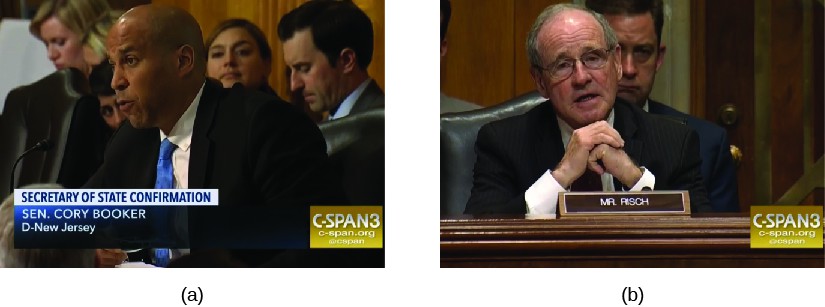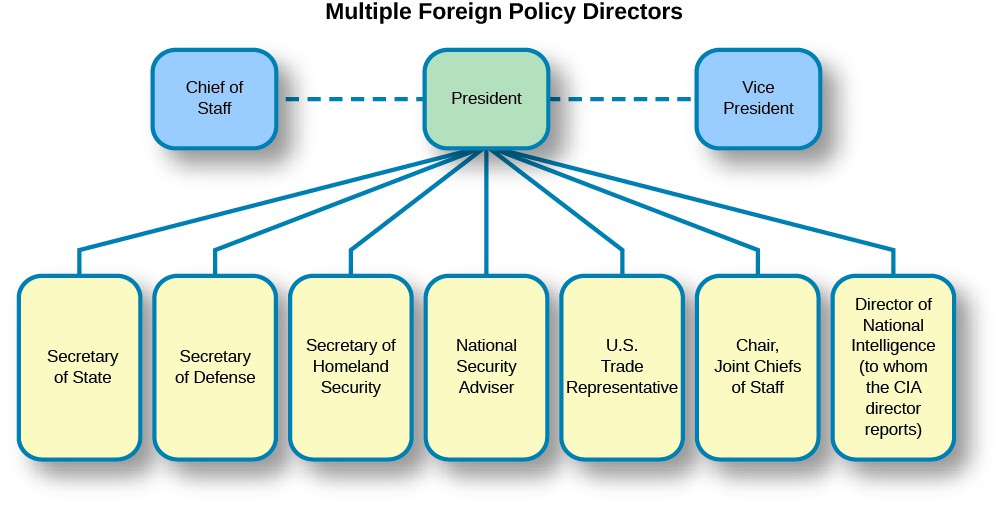10.6: Institutional Relations in Foreign Policy
- Page ID
- 147683
Institutional relationships in foreign policy constitute a paradox. On the one hand, there are aspects of foreign policymaking that necessarily engage multiple branches of government and a multiplicity of actors. Indeed, there is a complexity to foreign policy that is bewildering, in terms of both substance and process. On the other hand, foreign policymaking can sometimes call for nothing more than for the president to make a formal decision, quickly endorsed by the legislative branch.
Foreign Policy and Shared Power
While presidents are more empowered by the Constitution in foreign than in domestic policy, they must seek approval from Congress on a variety of matters; chief among these is the basic budgetary authority needed to run foreign policy programs. Even a sole executive agreement often requires subsequent funding from Congress in order to be carried out, and funding calls for majority support from the House and Senate. Presidents must consult with and engage Congress on many matters of foreign policy, and delegate a great deal to the bureaucratic experts in the foreign policy agencies. Not every operation can be run from the West Wing of the White House.
This chart shows the separation of powers and authority divided among executive and legislative branches, including in the foreign policy realm.
| Table 1. Roles of the President and Congress in Conducting Foreign Policy | ||
|---|---|---|
| Policy Output | Presidential Role | Congressional Role |
| Public laws | Proposes, signs into law | Proposes, approves for passage |
| Agency reauthorizations | Proposes, signs into law | Approves for passage |
| Foreign policy budget | Proposes, signs into law | Authorizes/appropriates for passage |
| Treaties | Negotiates, ratifies | Senate consents to treaty (two-thirds) |
| Sole executive agreements | Negotiates, approves | None (unless funding is required) |
| Congressional-executive agreements | Negotiates | Approves by majority vote |
| Declaration of war | Proposes | Approves by majority vote |
| Military use of force | Carries out operations at will (sixty days) | Approves for operations beyond sixty days |
| Presidential appointments | Nominates candidates | Senate approves by majority vote |
Nearly all major outputs of foreign policy require a formal congressional role in order to be carried out. Foreign policy might be done by executive say-so in times of crisis and in the handful of sole executive agreements that actually pertain to major issues (like the Iran Nuclear Agreement). In general, however, a consultative relationship between the branches in foreign policy is the usual result of their constitutional sharing of power.
Shared power creates an incentive for the branches to cooperate. Even in the midst of a crisis, such as the Cuban Missile Crisis in 1962, it is common for the president or senior staff to brief congressional leaders in order to keep them up to speed and ensure the country can stand unified on international matters. That said, there are areas of foreign policy where the president has more discretion, such as the operation of intelligence programs, the holding of foreign policy summits, and the mobilization of troops or agents in times of crisis. Moreover, presidents have more power and influence in foreign policymaking than they do in domestic policymaking.
The Two Presidencies Thesis
When the media cover a domestic controversy, such as social unrest or police brutality, reporters consult officials at different levels and in branches of government, as well as think tanks and advocacy groups. In contrast, when an international event occurs, such as a terrorist bombing in Paris or Brussels, the media flock predominately to one actor—the president of the United States—to get the official U.S. position.
The two presidencies thesis suggests that there are two distinct presidencies, one for foreign policy and one for domestic policy, and that presidents are more successful in foreign than domestic policy. Let’s look at the reasoning behind this thesis.
- The Constitution names the president as the commander-in-chief of the military, the nominating authority for executive officials and ambassadors, and the initial negotiator of foreign agreements and treaties. The president is the agenda-setter for foreign policy and may move unilaterally in some instances. Beyond the Constitution, presidents were also gradually given more authority to enter into international agreements without Senate consent by using the executive agreement. Laws, such as the War Powers Resolution of 1973, further promote this idea. Given all these powers, we have good reason to expect presidents to have more influence and be more successful in foreign than in domestic policy.
- The second reason has to do with the informal aspects of power. In some eras, Congress will be more willing to allow the president to be a clear leader and speak for the country. For instance, the Cold War between the Eastern bloc countries (led by the Soviet Union) and the West (led by the United States and Western European allies) prompted many to want a single actor to speak for the United States. A willing Congress allowed the president to take the lead because of urgent circumstances. In addition, the Cold War took place when the parties in Congress included more moderates on both sides of the aisle and the environment was less partisan than today. A phrase often heard at that time was, “Partisanship stops at the water’s edge.” This means that foreign policy matters should not be subject to the bitter disagreements seen in party politics.

Does the thesis’s expectation of a more successful foreign policy presidency apply today? While the president still has stronger foreign policy powers than domestic powers, the governing context has changed in two key ways. First, the Cold War ended in 1989 with the demolition of the Berlin Wall, the subsequent disintegration of the Soviet Union, and the eventual opening up of Eastern European territories to independence and democracy. These dramatic changes removed the competitive superpower aspect of the Cold War, in which the United States and the USSR were dueling rivals on the world stage. The absence of the Cold War has led to less of a rally-behind-the-president effect in the area of foreign policy.
Second, beginning in the 1980s and escalating in the 1990s, the Democratic and Republican parties began to become polarized in Congress. The moderate members in each party all but disappeared, while more ideologically motivated candidates began to win elections to the House and later the Senate. Hence, the Democrats in Congress became more liberal on average, the Republicans became more conservative, and the moderates from each party, who had been able to work together, were edged out. It became increasingly likely that the party opposite the president in Congress might be more willing to challenge his initiatives, whereas in the past it was rare for the opposition party to publicly stand against the president in foreign policy.
Finally, several analysts have tried applying the two presidencies thesis to contemporary presidential-congressional relationships in foreign policy. Is the two presidencies framework still valid in the more partisan post–Cold War era? The answer is mixed. On the one hand, presidents are more successful on foreign policy votes in the House and Senate, on average, than on domestic policy votes. However, the gap has narrowed. Moreover, analysis has also shown that presidents are opposed more often in Congress, even on the foreign policy votes they win.[2] Democratic leaders regularly challenged Republican George W. Bush on the Iraq War and it became common to see the most senior foreign relations committee members of the Republican Party opposing the foreign policy positions of Democratic president Barack Obama. Such challenging of the president by the opposition party simply didn’t happen during the Cold War.
During the Trump administration, there was been a distinct shift in foreign policy style. While for some regions, like South America, Trump was content to let the foreign policy bureaucracies proceed as they always have, in certain areas, the president has become quite pivotal in changing the direction of U.S. foreign policy. For example, he stepped away from two key international agreements—the Iran-Nuclear Deal and the Paris climate change accords. Moreover, in Syria, he employed bombing raids unilaterally on two occasions. This approach reflects more of a neoconservative foreign policy approach.
Therefore, it seems presidents no longer enjoy unanimous foreign policy support as they did in the early 1960s. They have to work harder to get a consensus and are more likely to face opposition. Still, because of their formal powers in foreign policy, presidents are overall more successful in foreign policy than in domestic policy.
The Perspective of House and Senate Members
Congress is a bicameral legislative institution with 100 senators serving in the Senate and 435 representatives serving in the House. How interested in foreign policy are typical House and Senate members?

Unless there is a foreign policy crisis, legislators in Congress tend to focus on domestic matters, mainly because there is not much to be gained with their constituents by pursuing foreign policy matters.[3] Domestic policy matters resonate more strongly with the voters at home. In other words, a sluggish economy, increasing health care costs, and crime matter more to them than U.S. policy toward North Korea. In an open-ended Gallup poll question from early 2016 about the “most important problem” in the United States, fewer than 15 percent of respondents named a foreign policy topic (half of those respondents mentioned immigration).[4]
Some House and Senate members ask to serve on the foreign policy committees, such as the Senate Committee on Foreign Relations, the House Foreign Affairs Committee, and the two defense committees. These members might have military bases within their districts or states and hence have a constituency reason for being interested in foreign policy. Legislators might also simply have a personal interest in foreign policy matters that drives their engagement in the issue. Finally, they may have ambitions to move into an executive branch position that deals with foreign policy matters, such as secretary of state or defense, CIA director, or even president.
For more information on the two key congressional committees on U.S. foreign policy, visit the Senate Committee on Foreign Relations and the House Foreign Affairs Committee websites.
The Many Actors in Foreign Policy
The White House staff members engaged in foreign policy are likely to have very regular contact with the president about their work.

Summary
Foreign policy can at times seem fragmented and diffuse because of the complexity of actors and topics. However, the president is clearly the leader, having both formal authority and the ability to delegate to Congress, as explained in the two presidencies thesis. With this leadership, presidents at times can make foreign policymaking quick and decisive, especially when it calls for executive agreements and the military use of force.
Resources
- Krutz and Peake. Treaty Politics and the Rise of Executive Agreements. ↵
- Jon Bond, Richard Fleisher, Stephen Hanna, and Glen S. Krutz. 2000. "The Demise of the. Two Presidencies," American Politics Quarterly 28, No. 1: 3–25. ↵
- James M. McCormick. 2010. American Foreign Policy and Process, 5th ed. Boston: Wadsworth. ↵
- The Gallup Organization, "Most Important Problem," http://www.gallup.com/poll/1675/most-important-problem.aspx (May 12, 2016). ↵
- American Government 2e. Authored by: OpenStax. Located at: https://cnx.org/contents/nY32AU8S@5.1:xJJkKaSK@5/Preface. License: CC BY: Attribution. License Terms: Download for free at http://cnx.org/contents/9d8df601-4f1...50bf739e5f@5.1

